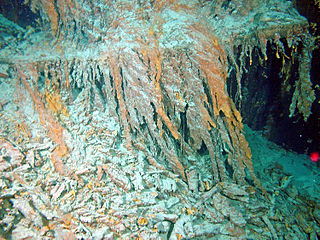
Halomonadaceae is a family of halophilic Proteobacteria.
Halomonas is a genus of halophilic (salt-tolerating) proteobacteria. It grows over the range of 5 to 25% NaCl.
Halopiger is a genus of archaeans in the family Halobacteriaceae that have high tolerance to salinity.
Jeotgalicoccus is a genus of Gram-positive, facultatively anaerobic, and halotolerant to halophilic bacteria. The cells are coccoid. The genus is named after the Korean fish sauce jeotgal, whence these bacteria were first isolated.
Halomonas venusta is a Gram-negative halophilic Proteobacteria, first described as Alcaligenes venustus and later reclassified as Halomonas venusta, along with other species when the genera Deleya, Halomonas, and Halovibrio and the species Paracoccus halodenitrificans were unified into a single genus, Halomonas, while the genus Zymobacter was placed in the family Halomonadaceae. The name stems from the Latin noun venusta which means "lovely" or "beautiful". It was originally isolated in marine water from Hawaii.
Dactylosporangium is a genus in the phylum Actinobacteria (Bacteria).
Alishewanella is a genus in the phylum Proteobacteria (bacteria).

Halomonas titanicae is a gram-negative, halophilic species of proteobacteria which was discovered on rusticles recovered from the wreck of the RMS Titanic. Cristina Sánchez-Porro et al. first isolated the bacterium in 2010 from a sample of rusticle obtained from the RMS Titanic in 1991. One of the researchers, Henrietta Mann has estimated that the action of microbes like Halomonas titanicae may bring about the total deterioration of the Titanic by 2030. While the bacteria have been identified as a potential danger to oil rigs and other man-made objects in the deep sea, it also has the potential to be used in bioremediation to accelerate the decomposition of shipwrecks littering the ocean floor.
Halomonas ventosae is a moderately halophilic, denitrifying, exopolysaccharide-producing bacterium. Its type strain is Al12T.
Halomonas alimentaria is a bacterium first isolated from jeotgal, a traditional Korean fermented seafood, hence its name. It is Gram-negative, moderately halophilic, non-motile and coccus- or short rod-shaped, with type strain YKJ-16T.
Halomonas hamiltonii is a halophilic bacteria first isolated from the environment surrounding dialysis patients. It is closely related to H. magadiensis.
Halomonas stevensii is a halophilic bacteria first isolated from dialysis patients and the environment surrounding them. Its genome has been sequenced.
Prauserella is a Gram-positive, aerobic and non-motile genus from the family of Pseudonocardiaceae.
Pontibacillus is a Gram-positive, spore-forming and strictly aerobic genus of bacteria from the family of Bacillaceae.
Salibacterium halochares is a Gram-positive, aerobic and halophilic bacterium from the genus of Salibacterium which has been isolated from a saltern from Mesolongi in Greece.
Salinimicrobium catena is a Gram-negative, aerobic, heterotrophic and non-motile bacterium from the genus of Salinimicrobium which has been isolated from sediments oft the South China Sea.
Kushneria aurantia is a Gram-negative, aerobic, non-spore-forming, rod-shaped and moderately halophilic bacterium from the genus of Kushneria which has been isolated from the surface of leaves from the mangrove Avicennia germinans.
Kushneria avicenniae is a Gram-negative and moderately halophilic bacterium from the genus of Kushneria which has been isolated from surface of leaves from the mangrove Avicennia germinans.
Kushneria indalinina is a moderately halophilic, Gram-negative, aerobic and motile bacterium from the genus of Kushneria which has been isolated from a solar saltern from Cabo de Gata.
Kushneria marisflavi is a Gram-negative and halophilic bacterium from the genus of Kushneria which has been isolated from the Yellow Sea in Korea.

